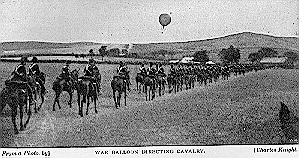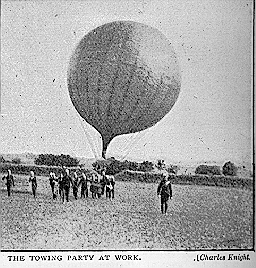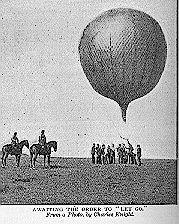WAR BALLOONING
By Charles Knight
(Strand Magazine, 1895)
The next European war will be a strange and fearful thing; everyone seems pretty sure about that. Writers of fiction with strong imaginations and a smattering of military science are constantly producing forecasts of this fascinating subject. We learn that Mr Maxim's guns will be very much to the fore; probably also, Mr Maxim's embryonic flying machines. Then we hear of messenger dogs, swarms of poisonous flies, and above all - in a dual sense - war balloons, whose mission will be to drop charges of dynamite and things of that kind upon all and sundry whom it is advisable to destroy.
All this leads up to the fact that we have a full-blown School of Ballooning at Aldershot, under the direction of Colonel Templer, whose name for many years has been associated with advanced military science, especially as regards the war balloon.The school at Aldershot is at present established in the Stanhope Lines, where large buildings have been erected on what was a few years ago nothing but a dangerous swamp. Colonel Templer is assisted in his very interesting work by Sergeant-Major Greener; and the accompanying group shows the entire staff of the first division of the Balloon Section when in the field, i .e., these men work the balloon.
.e., these men work the balloon.
Without exception, these men are enthusiasts in their work, and although they are associated with what may be described as the most interesting and novel branch of the service, they themselves are by no means inflated. At any rate, there is very little doubt that the British taxpayer got his quid pro quo - and perhaps a little more - in return for last years ballooning grant, which was rather less than £3,000.
Colonel Templer generates his own gas from diluted sulphuric acid and granulated zinc. The lifting power of the hydrogen generated this way is much greater than that of ordinary coal gas, but then its cost is much more. When manufactured, the hydrogen is compressed at "100 atmospheres" pressure and stowed away, so to speak, into huge Siemens steel cylinders, each averaging about 90lbs in weight. Ten of these elongated tubes are placed for conveyance to the field of battle upon admirably contrived wagons, usually drawn by horses; of course, under certain conditions, the gallant Colonel could utilize the baggage train, of which he is so great an advocate.
It takes, as a very simple calculation will immediately show, two wagon loads of gas to inflate a balloon of 10,000 cubic feet capacity, such as shown in the accompanying illustration.
Here we have the working staff, with two lieutenants in command of the section, the wagon and its team, and lastly, the inevitable crowd of curious onlookers, with the still more inevitable sprinkling of the small boy genus, without which no operation of the kind would be complete.
The man standing upon the car affixes one end of a screw nozzle to the mouth of a gas cylinder, while another of the engineers places the connecting tube to the nozzle of the balloon. The man on the car the gently turns on a very nicely constructed valve, which permits the compressed gas to leave the cylinder only at a very moderate rate, The balloon inflated, we will suppose that Lieutenant Hume and a brother officer are told off for the duty of reconnoitring the enemy's position. The two officers take with them a map of the surrounding country, on the scale of 2in. to the square mile. Of course, they are provided with field glasses, and the moment they discern the enemy and are able to gauge his strength, they make certain notes upon the map, using for this purpose pencils of various colours; one colour denotes cavalry, another infantry, and so on.
In the next picture we see that everything is ready;
the crew are on board, and the men who are holding the giant captive are awaiting the order to "Let go". The moment this order is given the immense aerostat shoots straight up like a rocket, but pressure is gradually brought to bear on the connecting rope, and when at an altitude of several hundred feet, the upward course of the huge machine is checked, and it sways gently to and fro, while the skilful officers in the car anxiously scan the magnificent prospect of country far below them. The moment any definite information is obtained as to the enemy's movements, the map spoken of above is marked according to such information, and then placed in a canvas bag to which a ring is attached in such a way that it glides swiftly down the rope to the ground, where a mounted orderly is in waiting. The orderly immediately gallops off with the very latest intelligence to the General in command. The British war balloon has long since ceased to be manufactured from silk - though this material is even now generally used by professional parachutists and aeronaut for their "envelopes". After many experiments, however, a perfectly impermeable material has been manufactured from ox-gut by a series of secret processes.
It is an interesting fact that in the manufacturing shed at Aldershot, women are employed in the making of the balloons, with are for the most part of a capacity equal to 10,000 cubic feet, and have when fully inflated a lifting power of something like 700lb.
There are at present in the store-room at Aldershot thirty-two fully equipped balloons, ready at an hour's notice to go on active service; and what is more, if, in actual warefare, they are found as useful as they have been in manouvers, their actual value will not have been at all over-estimated.
The envelope of the balloon is enclosed in a net-work of very strong cord, which is fastened below the nozzle of the balloon to a stout hoop that supports the car. The chord is manufactured by a justly-celebrated firm of rope-makers in the North of England, from hemp specially grown in sunny Italy; and although it is so light that a section 100ft long does not weigh a pound, and it is only about 1in. in diameter, yet will stand a strain of 500lb. without breaking. I have myself seen this cord practically tested by Sergeant-Major Greener on a dynamometer. The car of the war balloon accommodates a couple of men, and it is made of very strong wicker work. It is 2ft 3in. deep, the same in width, and 3ft 6in long. This car is fastened to the hoop above by very strong ropes; and of course for reconnoitring purposes, it is supplied with a grapnel, a captive rope, a photographic outfit, and many other articles that are carried in the common or Crystal Palace variety of balloon.
In the next illustration is seen the most direct and valuable mode of communication between the officers in the car of the war balloon and the forces below. I refer to telephonic communication.

In the picture it will be seen that a light wagon carries the necessary electrical plant. On the occasion of my own visit to the scene of operations, I watched an orderly gallop up to this wonderful piece of portable mechanism, and he roared into the cart as it were, "Any fresh information?"
The officer, with a truly astonishing quickness, gained most important news, receiving a reply which ran as follows: "There is a large body of cavalry on your right flank, behind the hill, deployed ready to charge the supports." This message came in an amazingly sharp and articulate voice - a veritable viva-voce message from the clouds.
The accompanying reproduction shows the Aldershot war balloon "Talisman" reconnoitring at such an altitude as to command the entire radius of country over which the manoeuvres are being conducted. It will be noticed that on the windward side the balloon is rather flat, instead of convex; this indicates that there is a vacuum, so it is coming down to be refilled. The body of cavalry seen is being wholly guided by instructions received from the "Talisman"

The system of reconnaissance by pencil-coloured maps dropped from the balloon at present holds the field against photography; but it must not be assumed that the camera is a wholly futile ally on the battlefield. As a matter of fact, most successful and valuable pictures are constantly obtained, showing in most beautiful detail the nature of the surrounding country and the obstacles to be encountered. You must remember, though, it takes at least half an hour to photograph, develop and dry the negative, and print a proof; from which it is obvious that information given to the commanding officer by this means is a little stale, as it conveys to him rather where his opponent was, than where he is at the moment.
When the officers in the balloon have procured all the information possible regarding the movements of the enemy, the war balloon is brought down, and is towed into some sheltered valley by the men of the balloon section, as is seen in the last photograph reproduced here;

then, of course, the balloon is placed under sentry protection. Not that much protection is needed, save, perhaps, from the derision of the small boy genus before referred to. I distinctly remember seeing a balloon towing party followed by a troop of gamins, who, far from being impressed by the huge machine, gave tongue from time to time and implored the men to "tike it 'ome".
Such is the work of the captive balloon. There are times, however, when Sergeant-Major Greener and other officers release the captive and travel to different parts of the surrounding country at a speed of perhaps forty miles an hour. As one might imagine, however, this speed is hardly noticed by the occupants of the balloon.
At the Aldershot School of Ballooning, selected officers go through a course of instruction at appointed seasons; and altogether, we may feel assured that we are well to the fore, as a nation, in the science of belligerent aeronautics.





